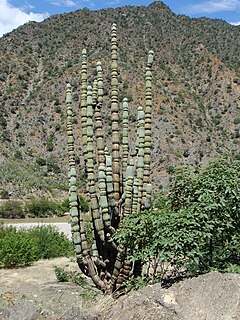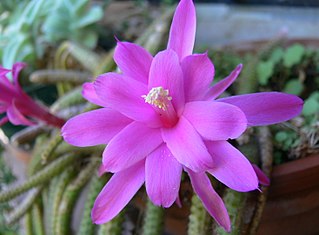
Night-blooming cereus is the common name referring to a large number of flowering ceroid cacti that bloom at night. The flowers are short lived, and some of these species, such as Selenicereus grandiflorus, bloom only once a year, for a single night. Other names for one or more cacti with this habit are princess of the night, Honolulu queen, Christ in the manger, dama de noche and queen of the night.

Acanthocereus is a genus of cacti. Its species take the form of shrubs with arching or climbing stems up to several meters in height. The generic name is derived from the Greek word άκανθα (acantha), meaning spine, and the Latin word cereus, meaning candle.

Pachycereus is a genus of 9–12 species of large cacti native to Mexico and just into southern Arizona, United States. They form large shrubs or small trees up to 15 m or more tall, with stout stems up to 1 m in diameter.

Armatocereus is a genus of mostly tree-like cacti from South America. These species have a conspicuous constriction at the end of the annual growth. The flowers are mostly white, with a more or less spiny ovary. The fruits are mostly spiny.

Jasminocereus is a genus of cacti with only one species, Jasminocereus thouarsii, endemic to the Galápagos Islands, territorially a part of Ecuador. In English it is often called the candelabra cactus. At maturity it has a branched, treelike habit, and may be up to 7 m (23 ft) tall. The stems are made up of individual sections with constrictions between them. Its creamy white to greenish flowers open at night and are followed by greenish to reddish fruits.

Cipocereus is a genus of cacti from Brazil. These species were previously included in the genera Pilosocereus and Cereus.

Selenicereus, or moonlight cacti, is an epiphytic, lithophytic, and terrestrial cactus genus found in Central America, the Caribbean and northern South America.

Peniocereus is a genus of vining cacti, comprising about 18 species, found from the southwestern United States and Mexico. They have a large underground tuber, thin and inconspicuous stems.
Its name comes from the prefix penio- and Cereus, the large genus from which it was split.

The lava cactus is a species of cactus, Brachycereus nesioticus, the sole species of the genus Brachycereus. The plant is a colonizer of lava fields – hence its common name – where it forms spiny clumps up to 60 cm (24 in) tall. Its solitary white or yellowish white flowers open in the daytime. It is endemic to the Galápagos Islands.

Oreocereus is a genus of cacti, known only from high altitudes of the Andes.
Its name means "mountain cereus", formed from the Greek prefix oreo- and the New Latin cereus, meaning wax or torch.

Echinopsis spachiana, commonly known as the golden torch, (white) torch cactus or golden column, is a species of cactus native to South America. Previously known as Trichocereus spachianus for many years, it is commonly cultivated as a pot or rockery plant worldwide. It has a columnar habit, with a lime-green cylindrical body with 1–2 cm long golden spines.

Disocactus flagelliformis, the rattail cactus, is a species of Cactaceae and is the most cultivated species in the genus. Due to its ease of cultivation and attractive floral displays, D. flagelliformis is often grown as an ornamental potted plant.

A pitaya or pitahaya is the fruit of several different cactus species indigenous to the Americas. Pitaya usually refers to fruit of the genus Stenocereus, while pitahaya or dragon fruit refers to fruit of the genus Hylocereus, both in the Cactaceae family. The dragon fruit is cultivated in Southeast Asia, Florida, the Caribbean, Australia, and throughout tropical and subtropical world regions.

Pachycereus marginatus is a species of plant in the Cactaceae family. It has columnar trunks that grow slowly to 12 feet (3.7m) and may reach 20 feet (6.1m) in height. Stems are 3 to 4 inches (9–10 cm) in diameter; ribs 5 to 7 inches (13–18 cm). Its central spine is about 3/8 inch (1 cm) in diameter with 5-9 radials and slightly yellowish in colour. Its cuttings are sometimes used to create fences as its spines are not as large or dangerous as some cacti.
Cereus chalybaeus is a cactus from the genus Cereus, a genus consisting of about 25 species of tree-like cacti. Cereus chalybaeus is a columnar cactus with 5-6 ribbs. It is few-branched and often purple tinged. It has spines that at first are red, but with age turn black. In summer it bears funnel-shaped flowers, which can be up to 8 inches long. The inner petals are white and the outer petals are either purple or red. Cereus chalybaeus can grow up to 10 feet tall and can be up to 28 inches in diameter. This plant is native in hardiness zones 13-15.

Cereus pedunculatus or the daisy anemone is a species of sea anemone in the family Sagartiidae. It is found in shallow parts of the northeast Atlantic Ocean and in the North Sea and the Mediterranean Sea. It is an omnivore, predator and scavenger.

Anemonia is a genus of sea anemones belonging to the family Actiniidae.

















